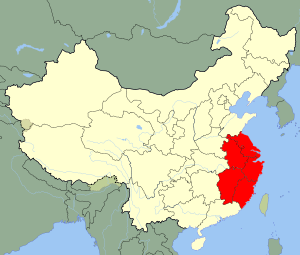Nanjing Military Region
You can helpexpand this article with text translated fromthe corresponding articlein Chinese.(March 2023)Click [show] for important translation instructions.
|
| Nanjing Military Region | |||||||
|---|---|---|---|---|---|---|---|
 Nanjing Military Region (highlighted) | |||||||
| Simplified Chinese | Nam Kinh quân khu | ||||||
| Traditional Chinese | Nam Kinh quân khu | ||||||
| |||||||
TheNanjing Military Region(Chinese:Nam Kinh quân khu) was one of the former sevenmilitary command regionsfor the ChinesePeople's Liberation Army.Its jurisdiction covers all military and armed police located inAnhui,Jiangsu,Zhe gian g,Jiangxi,Fu gian,andShanghai.It also coversTaiwan,which is claimed by thePeople's Republic of Chinabut administered by theRepublic of China.The head of the region wasCai Yingting.This region is now part of theEastern Theater Command.
The60th Corpswas active in the Nanjing Military Region until disbanded in late 1985.
In 2005, theInternational Institute for Strategic Studieslisted the formation with an estimated 250,000 personnel, three group armies (1st,12th,and31st Group Armies), two armoured, one mechanised infantry, three motorised infantry, and one artillery division.[1]There were also one armoured, four motorised infantry, two artillery, three anti-aircraft brigades, plus an anti-tank regiment.
The headquarters for theEast Sea Fleetwere located within the region, atNingbo.
Tentative order of battle 2013
[edit]Dennis J. Blasko's 'The Chinese Army Today: Tradition and Transformation for the 21st Century' listed formations within the Nanjing MR as:[2]
- 1st Group Army(Huzhou, Zhe gian g)
- 12th Group Army(Xuzhou, Jiangsu)
- 34th Mechanized Infantry Brigade(Chuzhou (Sanjie)), Anhui
- 36th Mechanized Infantry Brigade(Xinye, Jiangsu)
- 179th Mechanized Infantry Brigade(Nan gian g, Jiangsu) ('Linfen Brigade')
- 2nd Armored Division(Xuzhou, Jiangsu)
- Artillery Brigade (Xuzhou, Jiangsu)
- Air Defence Brigade (Huai'an, Jiangsu)
- 31st Group Army(Xiamen, Fu gian )
- 86th Motorized Infantry Division(Fuzhou, Fu gian )
- 91st Motorized Infantry Division(Zhangzhou, Fu gian )
- 92nd Motorized Infantry Brigade(Nan'an, Quanzhou, Fu gian )
- Amphibious Armoured Brigade (Zhangzhou, Fu gian )
- 3rd Artillery Brigade(Quanzhou, Fu gian )
- 13th Air Defence Brigade (Xiamen, Fu gian )
- 10th Army Aviation Regiment (Xiamen, Fu gian )
- Flying Dragon Special Operations Dadui (Zhangzhou, Fu gian )
- Shanghai Garrison
- Two coastal defence brigades
- Other Units subordinate to MD or MR
- 31st Pontoon Bridge Brigade, Jiangsu MD
Among listedPeople's Liberation Army Air Forceunits in the region before the transition to theEastern Theater Commandwere the3rd Fighter Division,10th Bomber Division,flying the H-6, the14th Fighter Division,the28th Attack Division,the29th Fighter Division,and the 3rd Independent Regiment.
The 32nd Air Division atRugaobecame the Military Region Air Force Training Base. In the early 1990s over 1000 surplus fighters were stored at Rugao.[3]
The 4th Air Corps was established in Shanghai in August 1952, though Whitson indicates that Nieh F'eng-chih took command of the 4th Air Corps in late 1950s. The unit was later changed to the Shanghai Command Post. In the early 1950s, two divisions from the29th Corpswere transferred to the 4th Air Corps. In 1993, it became the Shanghai Base.
The5th Air Corpsmoved toHangzhouby 1954, but was abolished in April 1976.[4]Its command staff were moved toKunmingand the Kunming MRAF CP retitled the 5th Air Corps.
List of commanders
[edit]
- Xu Shiyou
- Ding Sheng
- Nie Fengzhi
- Xiang Shouzhi
- Gu Hui
- Chen Bingde
- Liang Guanglie
- Zhu Wenquan
- Zhao Keshi,2007−12
- Cai Yingting,2012−16
Nickname
[edit]Organizations affiliated with the Nanjing Military Region often used the nickname "frontline" (Chinese:Tiền tuyến;pinyin:qiánxiàn;lit.'front line'), including the Frontline Performance Troupe (Chinese:Tiền tuyến đoàn văn công) and thePeople's Frontline(Chinese:《 nhân dân tiền tuyến 》) newspaper.
References
[edit]Citations
[edit]- ^International Institute for Strategic Studies,the Military Balance 2005-6, Routledge, 2005, p.272
- ^Blasko 2013, Table 4.6, p.97
- ^"Chinese Air Arms OrBat".oja.link.Retrieved2019-01-12.
- ^Allen RAND 2002, 444.
Sources
[edit]- Blasko, Dennis J. (2013).The Chinese Army Today: Tradition and Transformation for the 21st Century.Routledge.ISBN9781136519970.
